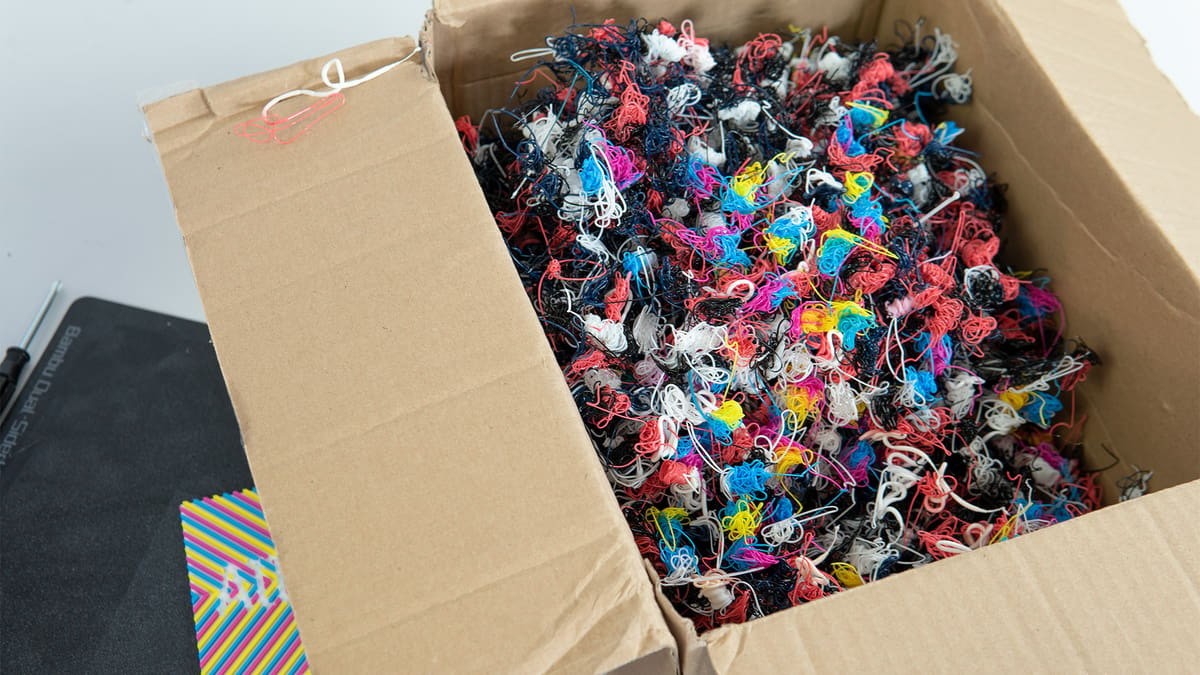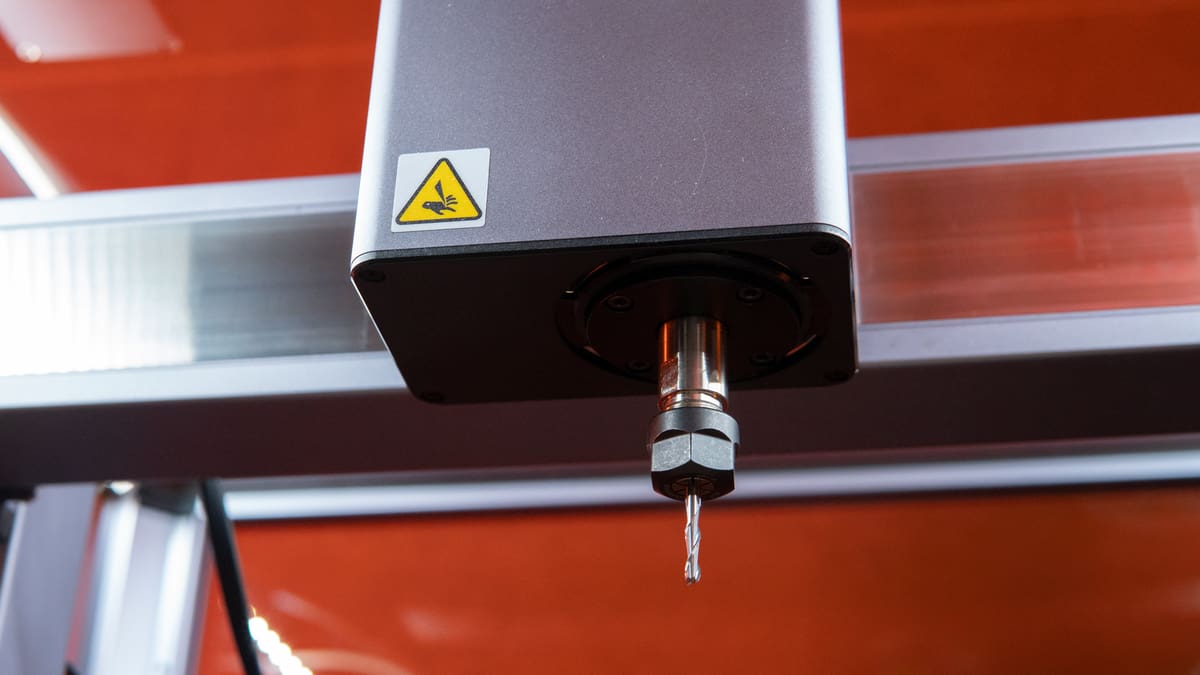Bambu Lab is, undeniably, the fastest-growing desktop 3D printer manufacturer of the last couple years, with private individuals and businesses alike jumping on board the company’s particular brand of quick, convenient 3D printing.
Naturally, there’s an insatiable appetite for more from the company. And with some classes and sizes of 3D printer not yet covered by Bambu Lab, paired with their stratospheric popularity, the question on many folks’ minds is: “What’s next?”
To begin, let’s recap what we do know.
Things We Know

There is a new series of machine coming.
Because of course, there’s something else coming and the company has, across various mediums and occasions, confirmed it is working on something new. Next.
It’ll be bigger than the company’s existing machines.
The release of the A1 Mini surprised many by leaving the possibility of the much-requested larger machine out in the cold. In an interview with CNC Kitchen in 2023, Bambu Lab co-founder and CEO Ye Tao acknowledged the demand, explaining that the company’s limited resources and approach to product development – using a central stack of tech and competencies and then forking them to develop its machines – left the company with the choice between simply scaling up the existing printer to satisfy the simple demand, or to wait until it could accompany the increase in size with something “more interesting”.
That the new machine would be bigger was also subsequently confirmed in a Reddit AMA where a company account confirmed that they were “working on it” and also in a conversation between All3DP’s Shawn Frey and Bambu Lab co-founder Huaiyu “Sprite” Liu at the Rapid + TCT trade show in the summer of 2024. “Everybody’s asking for a bigger printer, so we had to work on it,” said Liu.
It will not be arriving in 2024.
Despite strongly suggesting in the AMA that the new printer would arrive in 2024, and confirming it in our interview, a revision of this timeline, recently announced by the company, has Bambu Lab pushing the new machine’s debut to 2025. The reasons cited for this largely hinge on allowing more time for quality control and ensuring sufficient stock is available worldwide for the machine’s launch.
It will be a “prosumer” machine sitting above the X1-series.
As was confirmed in Bambu Lab’s delay announcement, the new machine is positioned above the company’s current flagship, the X1C. Presumably, this also means the enterprise-oriented X1E, too.
The word “prosumer” often trips folks up as to the intended meaning. Even here at All3DP we’ve wobbled on its use and generally try to avoid it to prevent confusion. A literal definition is a consumer-level user that demands and invests in top-spec equipment.
The company clearly sees this next generation as a step up on what has come before, so that handily dispels any notion that whatever it is will be a simple scaling up of the existing hardware.
Things We Think Are Likely

So that settles what we do know. Now to the things we don’t know for sure, but have a pretty good feeling about.
It’ll have a 360 x 360 mm build area.
Creality’s K1 Max is a machine we often see listed as the option for those too impatient to wait for whatever larger machine Bambu Lab releases next, but the 300 x 300 mm build area it offers seems like too much of a compromise to me. The P-series, X1-series, and A1 3D printers all have a 256 x 256 mm build area, so a jump to 300 x 300 mm is too marginal for a highly anticipated larger Bambu Lab machine.
The Prusa XL puts a comfortable distance between the “standard” MK4 build area with its 360 x 360 mm of printable space, and with many forum and social media threads begging for something in that direction, it’s too tempting not to suggest.
That being said…
There will be more than one machine.
Bambu Lab established early on that it offers more than single-product series of printers and accessories. Variant devices cover different price points and, marginally, capabilities. You can bet that with any innovations introduced in the new series, there will be multiple points of entry, particularly if our next theory bears out.
It will have multiple nozzles or toolheads, each independently capable of multicolor/material.
This one seems quite logical given the general situation we’re looking at with this mystery machine. Bambu Lab is known for easy multicolor printing, and high-level execs of the company have said outright they won’t simply be scaling up the existing products, which means it surely will not be another single-nozzle filament 3D printer that’s capable of multicolor via a device like the AMS.
Looking at recent patent filings under Bambu Lab’s trade name in China, Shenzhen Tuozhu Ltd, reveals one possibly relevant filing from early 2024 which details a color-changing system of “at least two printheads,” each independently fed by multiple spools. The drawings for the filing show an A1 Mini with two printheads each fed by a separate AMS Lite device. Of course, IP filings can be utter word salad, and the drawings referred to merely representative (rather than an indication of an actual product).
Needless to say, an A1 Mini IDEX would be impractical, but the methods for independently feeding separate toolheads with multiple filaments would translate very well to a larger-size machine, be it IDEX, a dependent dual-nozzle setup, a toolchanger, or something else completely.
The illustration of an IDEX A1 Mini taken at face value could suggest a shared-axis approach to the multiple toolheads, but since that filing makes no specific mention of the kinematics of the multiple toolheads, I wouldn’t count on it.
It doesn’t share components with or can use far more than, the A-, P-, and X-series machines.
Bambu Lab’s note to delay the new machine to 2025 cited ensuring stock availability as one of its reasons to push the launch. While I’ll hold my hands up to this being an overly simplistic take, could it hint at an increased diversity of replaceable components – potentially even combinations and variations of the machine itself?
Backward compatibility of components between this and the other machines would make sense for user choice, though Bambu Lab hasn’t been afraid of segmenting its user base with hard walls between components of its machines and their compatibility with others. It perhaps wouldn’t feel so “prosumer” if any old A1 hot end fit, would it?
It will be less wasteful.
A common criticism of Bambu Lab’s current multicolor printing system is the amount of waste generated whenever a color change is made. Its particular approach, using an autoloader and having a sizable length of filament cut at each change that must be purged, has also had the unintended consequence of being emulated by other manufacturers also content with excessive filament waste as a consequence of color printing.
It can be done cleaner with less filament (see the MMU3,) but a change in kinematics to, for example, a toolchanger like the Prusa XL, a device commonly referenced as the direction fans want Bambu Lab’s new machine to go in, would also cut back on filament lost to purging the nozzle.
Given what we know about existing Bambu Lab printers, our theory of a multi-nozzle or toolhead system that can feed multiple materials to each nozzle independently would still require purging to print cleanly when filament changes are made within a group. From this, we can intuit that we’ll either see a wholesale change in Bambu Lab’s approach to single-nozzle multicolor that reduces filament waste.
Or we won’t; things stay the same and the waste remains.
Things That Are Plausible, But Unlikely

It can be fun to fantasize these things, so here are my full bore out-there theories that are less likely but, hey, a guy can dream.
It’s a hyperrealistic color printer (no filament).
Color plays a large part in Bambu Lab’s offering, with the myriad MakerLab tools on MakerWorld catering to creating multicolor models. The recent introduction of the PrintMon maker tool, which generates a 2D image from a text prompt and then 3D model from the 2D image, illustrates a problem with filament-based “color” in printing. When you skip down from the configurator’s options for twelve colors to eight, and then four, the model looks increasingly blocky, and, well, crap.
Even using a generous twelve colors of filament does little for the illusion – never mind the expectation of you even having twelve relevant filaments on hand to achieve such a print. There’s zero possibility of transitioning or gradating between the colors.
This abundance of AI model generation tools (you can be sure more are coming,) paired with comments in interviews reiterating the company’s desire to make printing even more accessible and open to those with no technical background, suggests that a destination for the company is the removal of such “noise” from the printing process. As it releases tools to help users create more complex color prints, using filament places a hard limit on the complexity of the color, unless the tech evolves closer to what’s currently offered at the industrial level for full-color printing.
The complications of moving into this space are neatly summarized in a post on Fabboloo. Such a move, tech-wise, would dramatically increase support material costs, and enter a mature market with big competition including (ahem) Stratasys. But, if there’s one thing Bambu Lab has proven it can do, it’s siphon users away from bigger additive industry players.
Overcoming the challenges would cut the waste in color prints for the regular user, replacing dozens of filaments with a simpler selection of base material, colorants, and support material.
It’s a scalable, multifunctional device.
I nod to this above in the theory that it shares few (or requires far more) components than Bambu Lab’s existing printers, but perhaps the additional testing and quality assurance, combined with taking the time to better stock up worldwide points to increased design complexity in the form of, actually, more of an inherently modular system, a-la Snapmaker.
Bambu Lab’s specialty in motor control and vibration dampening tech could be used in a multimodal creative tool to great effect. Hearsay has it that Bambu Lab has tapped a variety of laser manufacturers for samples which, and of the many possibilities this could suggest, one is laser engraving, cutting, and marking.
We’re tagging this theory as plausible, but highly unlikely, given the sheer overhead of expanding the software and safety aspects of the device to accommodate additional functions like a class 4 laser, which such devices typically are. Attitudes toward laser devices and laser safety vary, particularly between Europe and the rest of the world, and we can’t imagine Bambu Lab baking this into the core offering of this new machine. Not to mention that we can’t find any public demand for this from the company.
A huge dose of salt is required for this theory. While we’ve not been able to verify it, my guess is, if true, it’s more likely a continuation and expansion of the company’s laser-based features like the dual-laser lidar module.
So there we have it. A smattering of things we know and some things we think are likely, plus some wilder theories that have been fun to explore but highly unlikely.
What do you think? What would you like to see? Dissect (or support) my ideas in the comments.
Other reads:
License: The text of "What Is Bambu Lab’s Next Printer? What We Know (And Think) So Far" by All3DP is licensed under a Creative Commons Attribution 4.0 International License.
 Stay Informed, Save Big, Make More
Stay Informed, Save Big, Make More